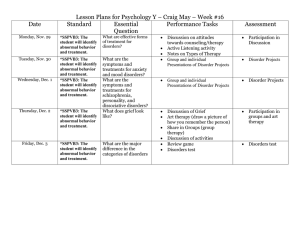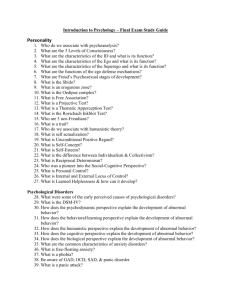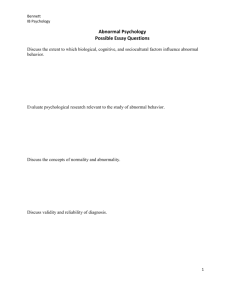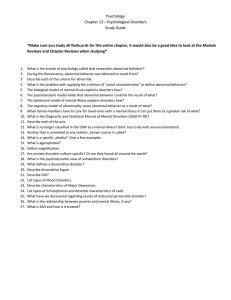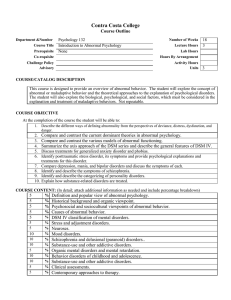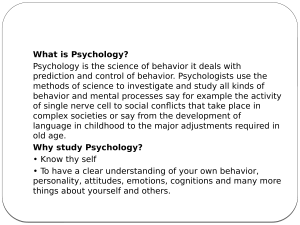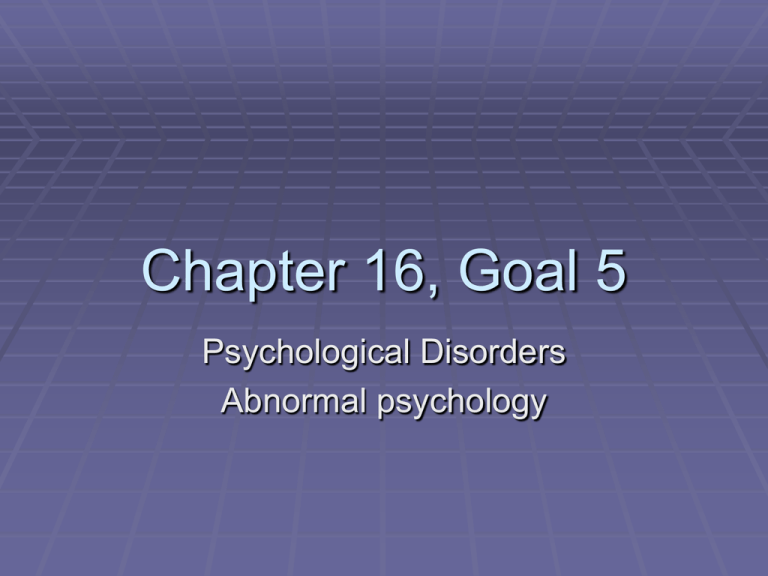
Chapter 16, Goal 5
Psychological Disorders
Abnormal psychology
What is the difference between
normal and abnormal behavior?
According to Rosenhan and Seligman(1984)
1. Suffering – does the person experience
distress and discomfort?
2. Maladaptiveness – does the person engage in
behaviors that make life difficult for him or her
rather than being helpful?
3. Irrationality – is the person incomprehensible
or unable to communicate
4. Unpredictability – does the person act in ways
that are unexpected by himself or herself or by
other people?
5. Vividness and unconventionality – does
the person experience things that are
different from most people?
6. Observer discomfort – is the person
acting in a way that is difficult to watch or
that makes other people embarrassed?
7. Violation of moral or ideal standards –
does the person habitually break the
accepted ethical and moral standards of
the culture?
The first four – how a person is living
Fifth – social judgment, what is convention
or not
Last two – social norms.
Problem with social judgments – often fail to
consider diversity in how people live their
lives –
Defining abnormality is PROBLEMATIC!!!
Jahoda’s (1958) normal
characteristics
Efficient self-perception
Realistic self-esteem and acceptance
Voluntary control of behavior
True perception of the world
Sustaining relationships and giving
affection
Self-direction and productivity
Criticism of Jahoda
If criteria were applied, most of us would
seem somehow abnormal
These are value judgements
Example: Changing views on
homosexuality
DSM-III (1980)Changed homosexuality from a
disorder to
“only abnormal if the individual has negative
feelings about his or her sexual orientation.”
DSM-IV (1994)
“Sexual disorders not otherwise specified” where it
is marked as “persistant and marked distress
about one’s sexual orientation”
What has happened in the meantime –
people’s attitudes have changed. It is no
longer considered abnormal and cannot
be classified as such
What is normal and not changes!!
DSM
The American Psychiataric Association
published a manual to list observable
symptoms
Diagnostic and Statistical Manual of
Mental Disorders
The 5th version (update) has just been
released.
Transsexualism
DSM-IV has classified as a disorder
Called gender identity disorder
After movie Boys Don’t Cry, there are
arguments to declassify it.
ABC’s of a disorder
Psychologists use this when describing symptoms of a
disorder
Affective symptons – emotional elements (fear,
sadness, anger)
Behavioral symptoms – observational
behaviours (crying, physical withdrawal from
others, pacing)
Cognitive symptoms – ways of thinking
(pessimism, personalization, self-image)
Somataic Symptoms – physical symptoms
(facial twitching, stomach cramping a
amenorrhea)
Criticisms in trying to identify
characteristics of “abnormality”
Some use these labels as an “excuse” for
behavior
Diagnosis are not objective, can be
influenced by culture and politics
In the former Soviet Union dissidents were
diagnosed as schizophrenic
In the UK in the 1800s women who were
pregnant and not married could be admitted
to an asylum.
Thomas Szasz
“The Myth of Mental Illness” 1962
Some neurophysiological disorders are
diseases of the brain (Alzheimers)
Most “mental disorders” should be
considered as “problems in living”
The concept of mental illness is not used
correctly by psychiatrists
Is Szasz’s argument valid today?
Neurophychologists have revealed
possible chemical abnormality in the brain
(schizophrenia)
But brain scans haven’t yet provided an
ultimate answer.
Szasz
Ideology and Insanity (1974)
People use labels such as mentally ill,
criminal or foreigner in order to socially
exclude people
Also, those labelled as mentally ill often
endure prejudice and discrimination
Rosenhan’s study
Shows the concerns about reliability in the
diagnosis of psychiatric illness.
2 psychiatrists can easily diagnose the
same patient with different disorders.
Bias in diagnosis, attitudes and prejudices
of the psychiatrist
Must rely on the patient himself to answer
questions about his own behavior – may
be unreliable.
Biopsychosocial Approach
Nature and Nurture
Biological causes
Psychological causes
Social Causes
different cultures have different anxiety disorders
anorexia-nervosa (western cultures)
Susto, fear of black magic (Latin America)
Taijim-kyofusho (eye contact ???) Japan
Andrea Yates
http://www.youtube.com/watch?v=S3xN__
s2-KQ


